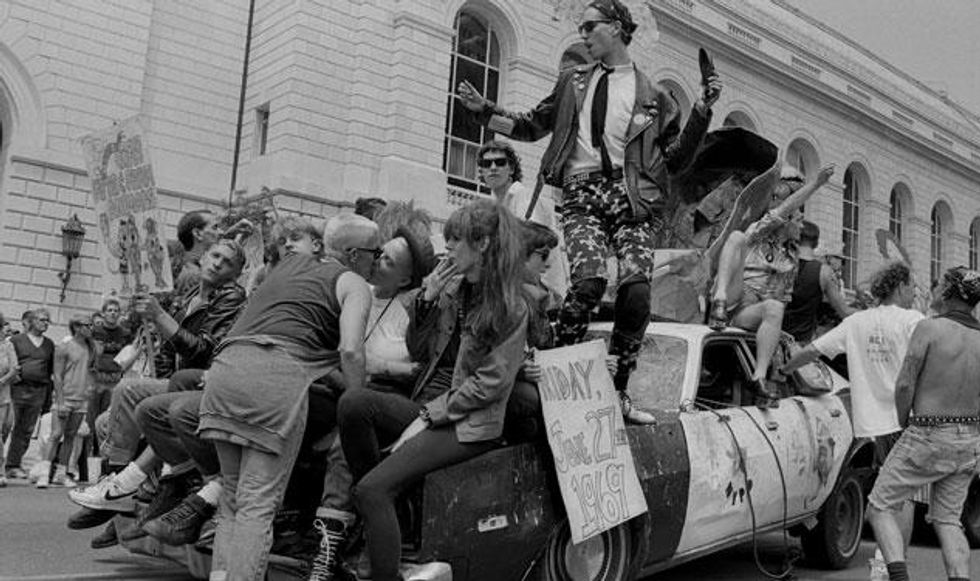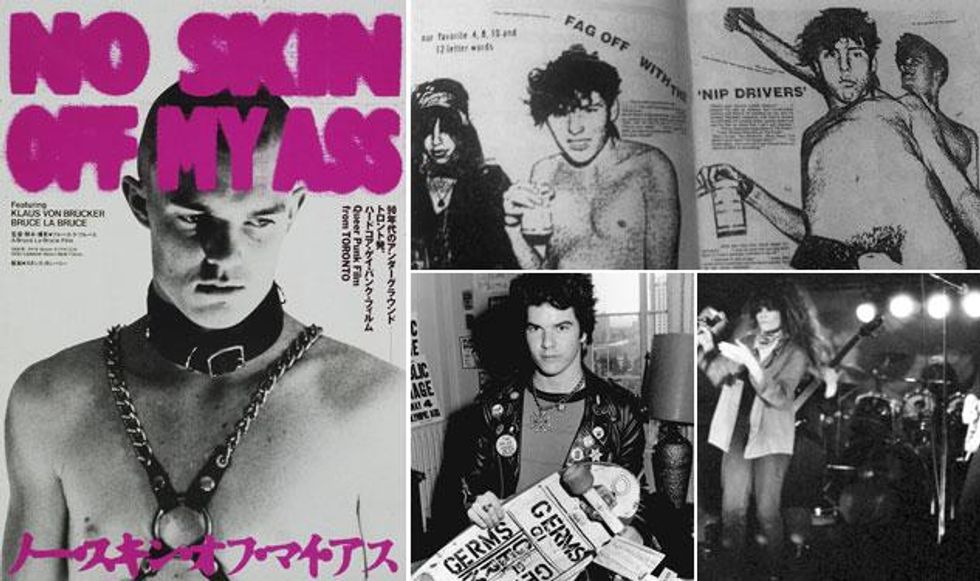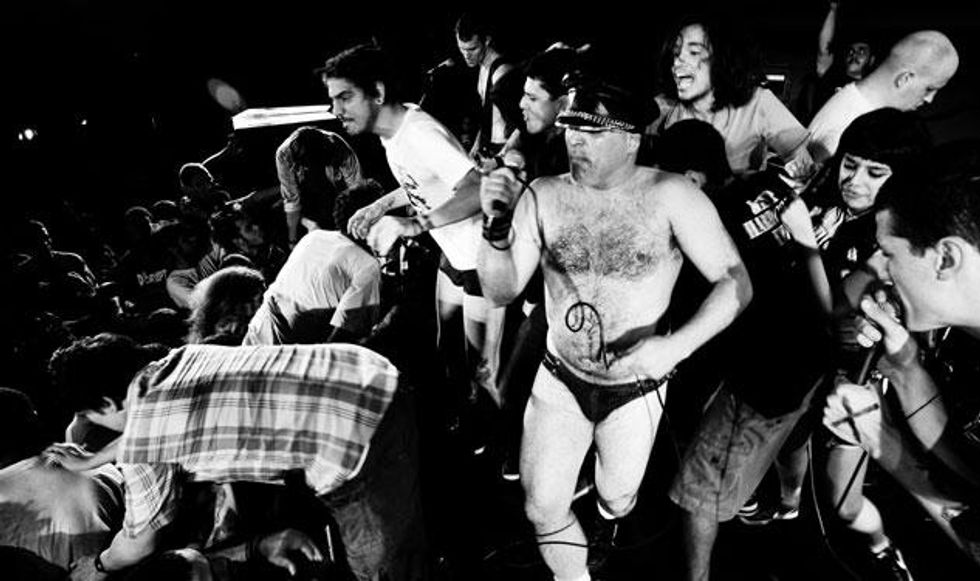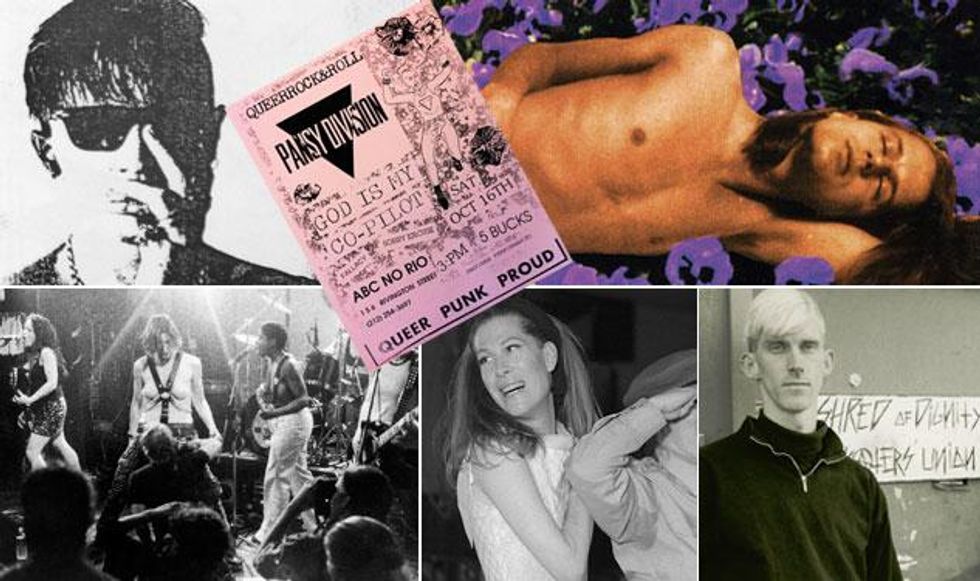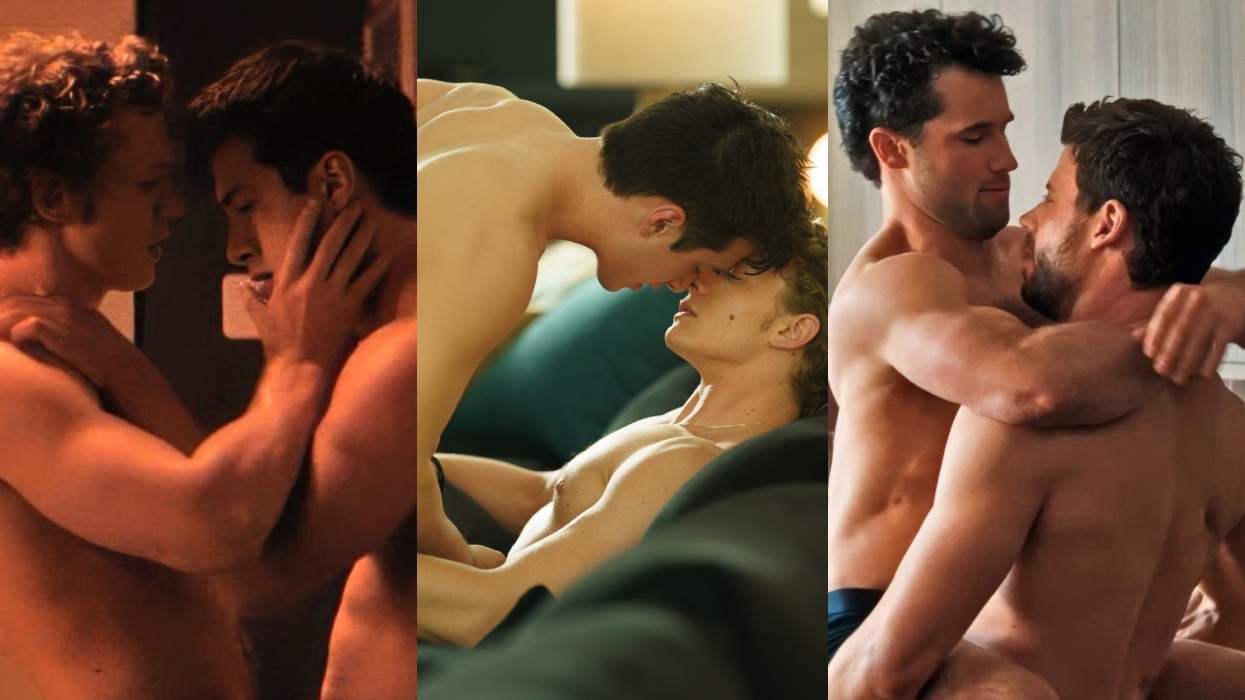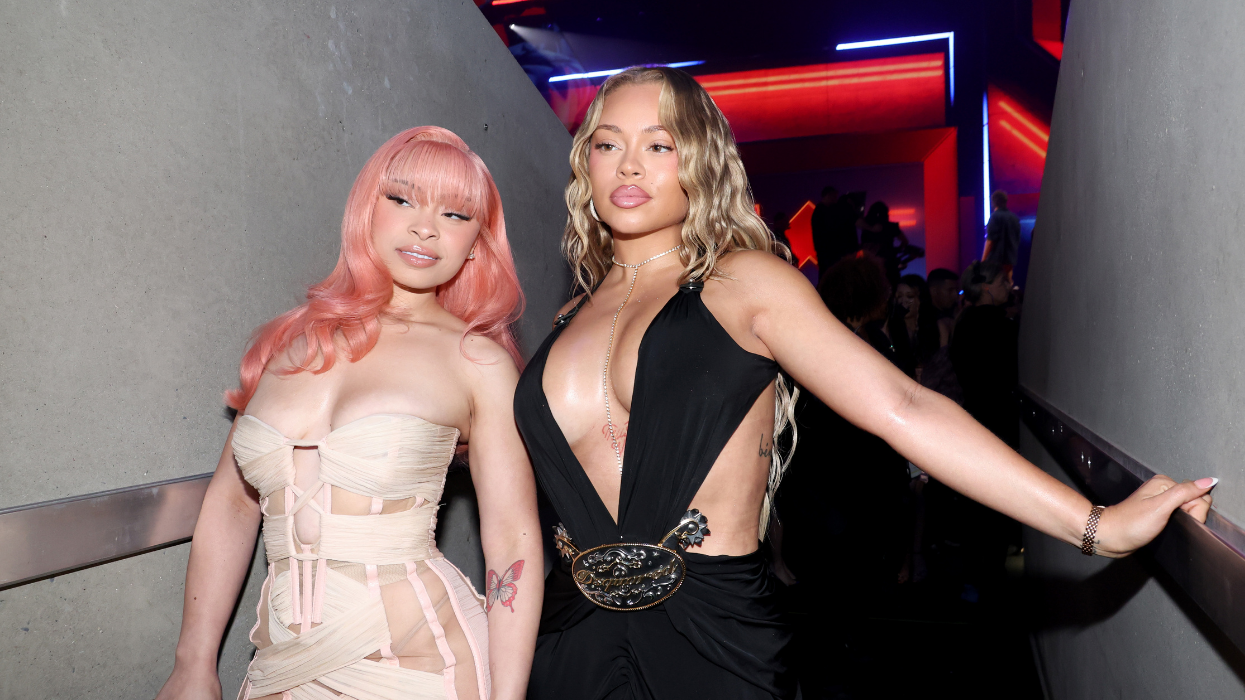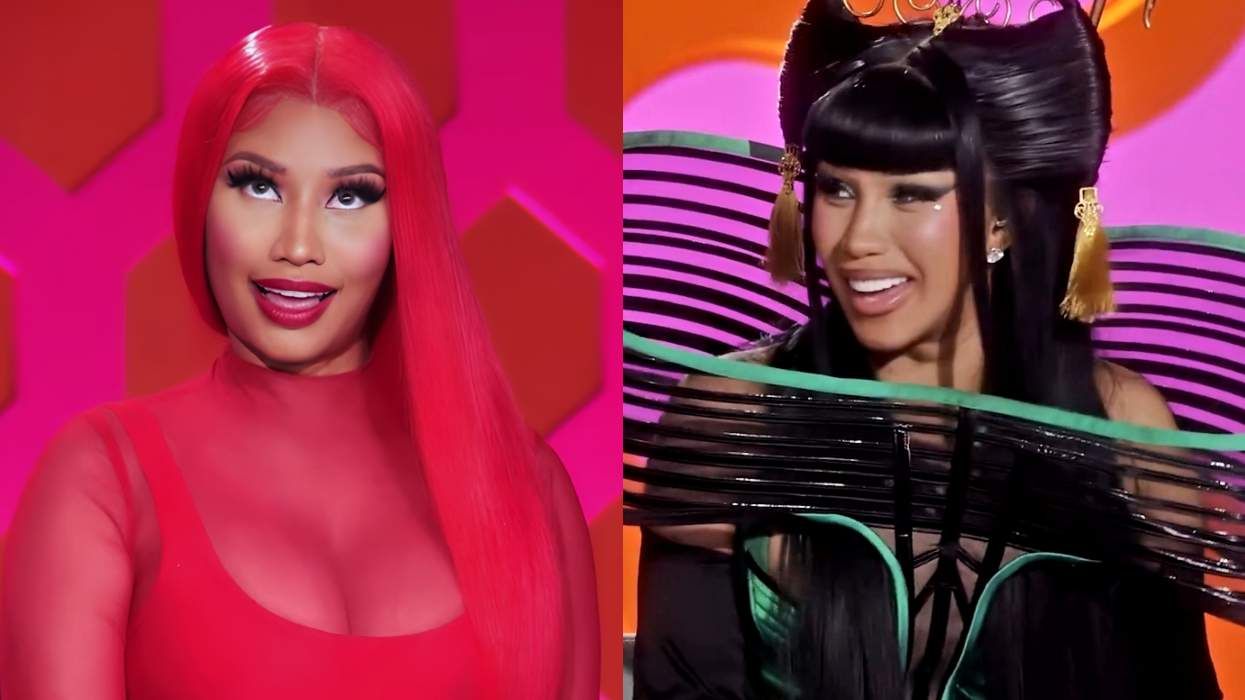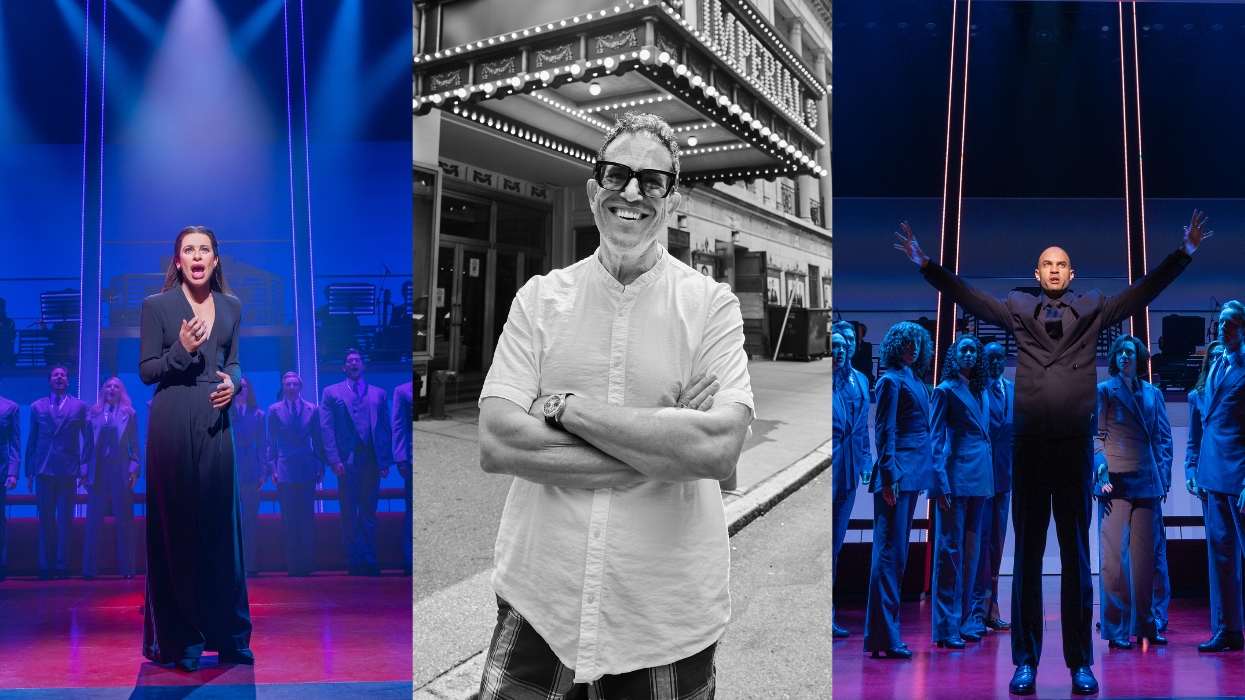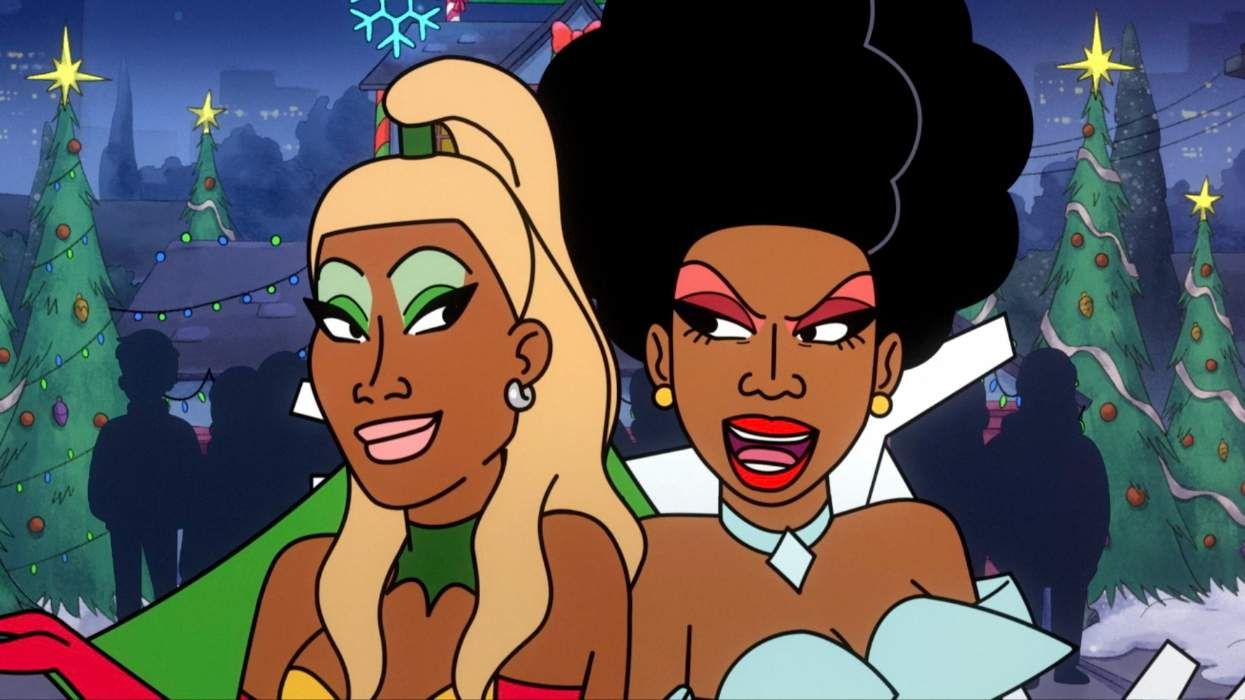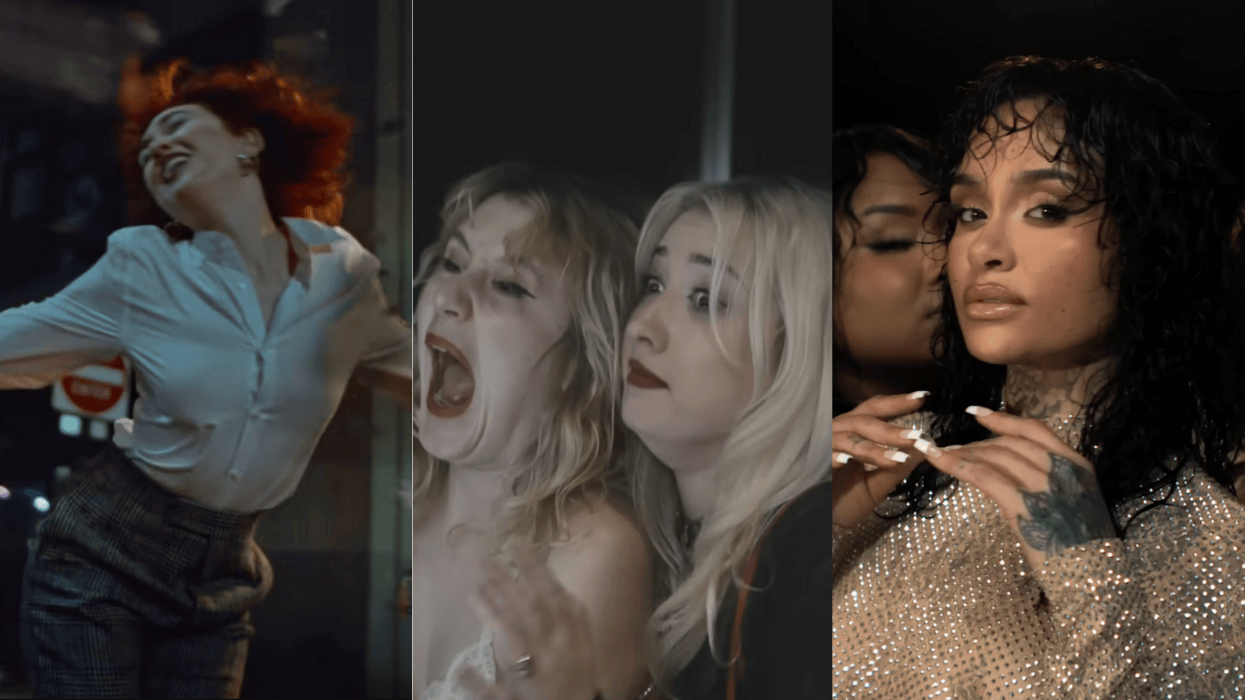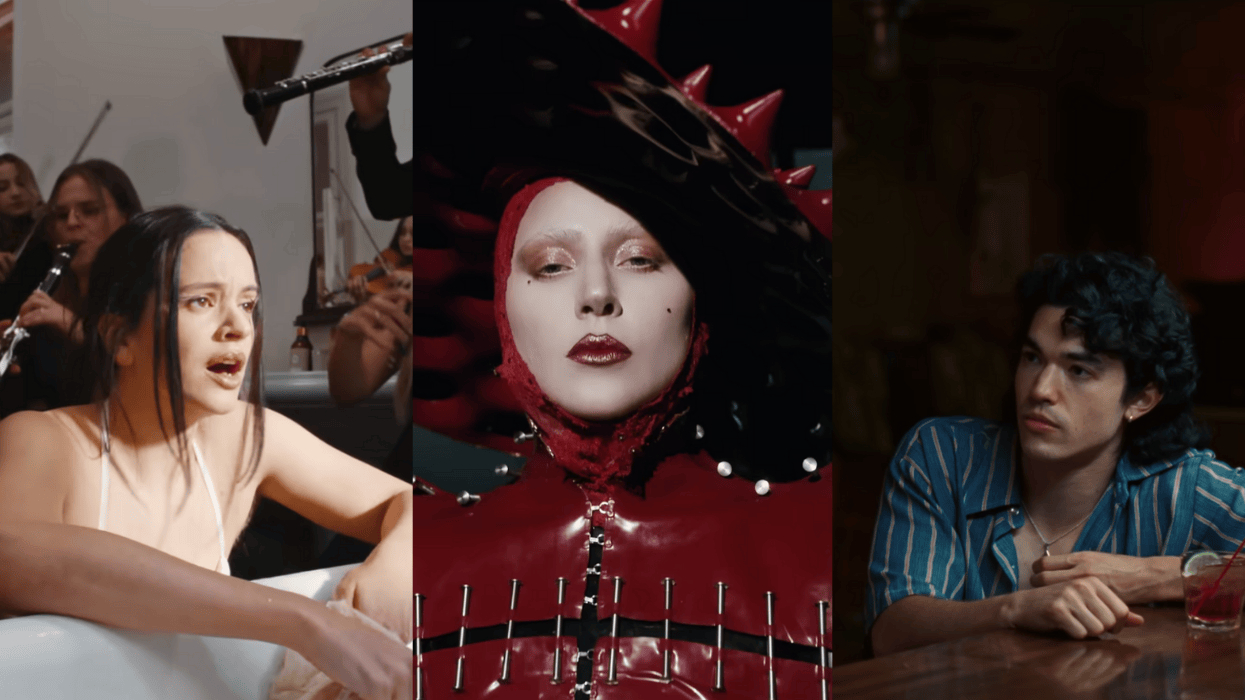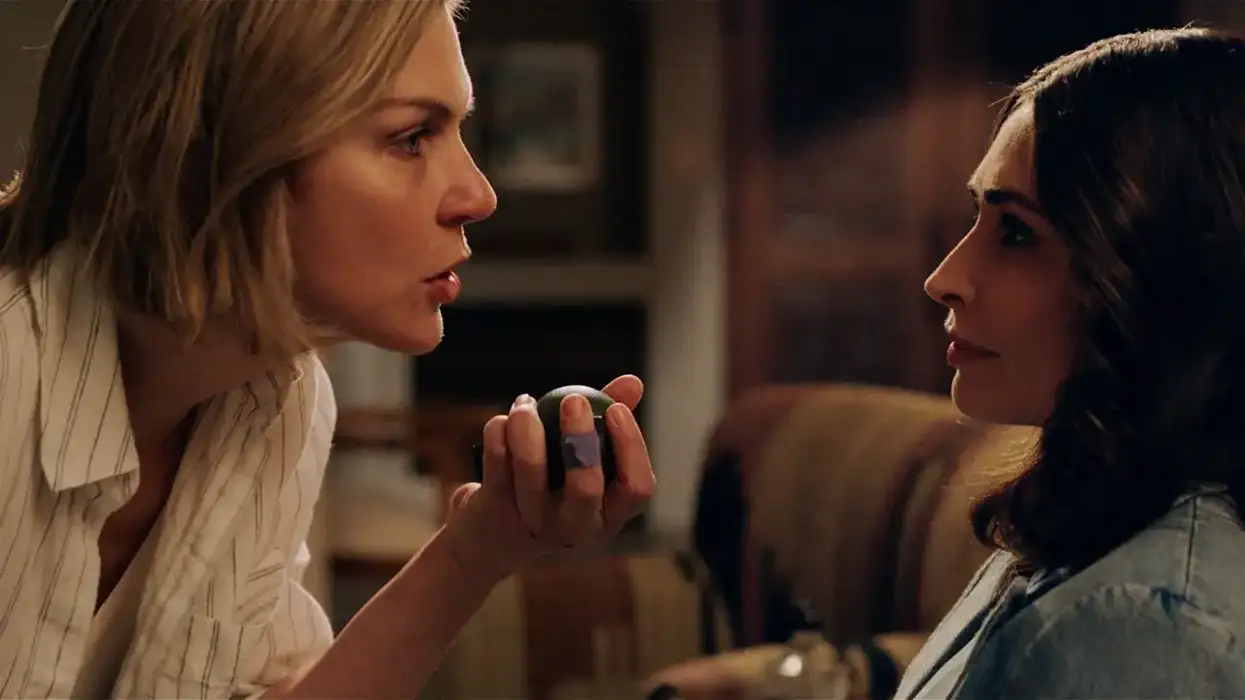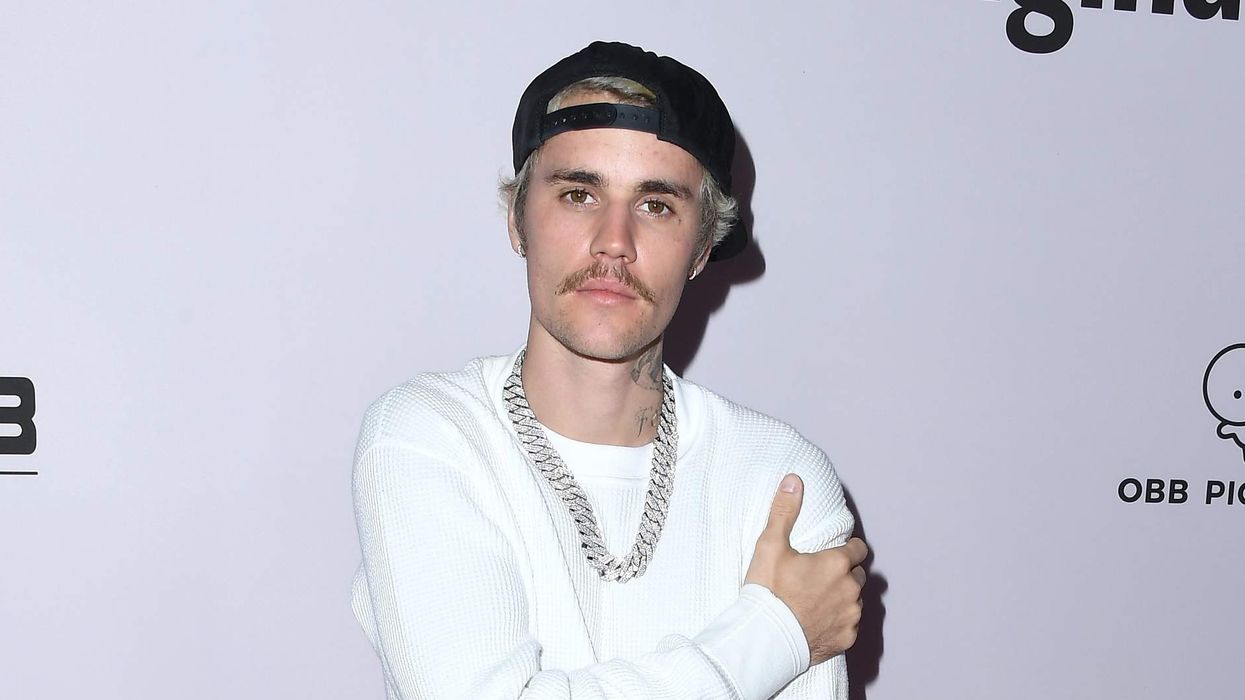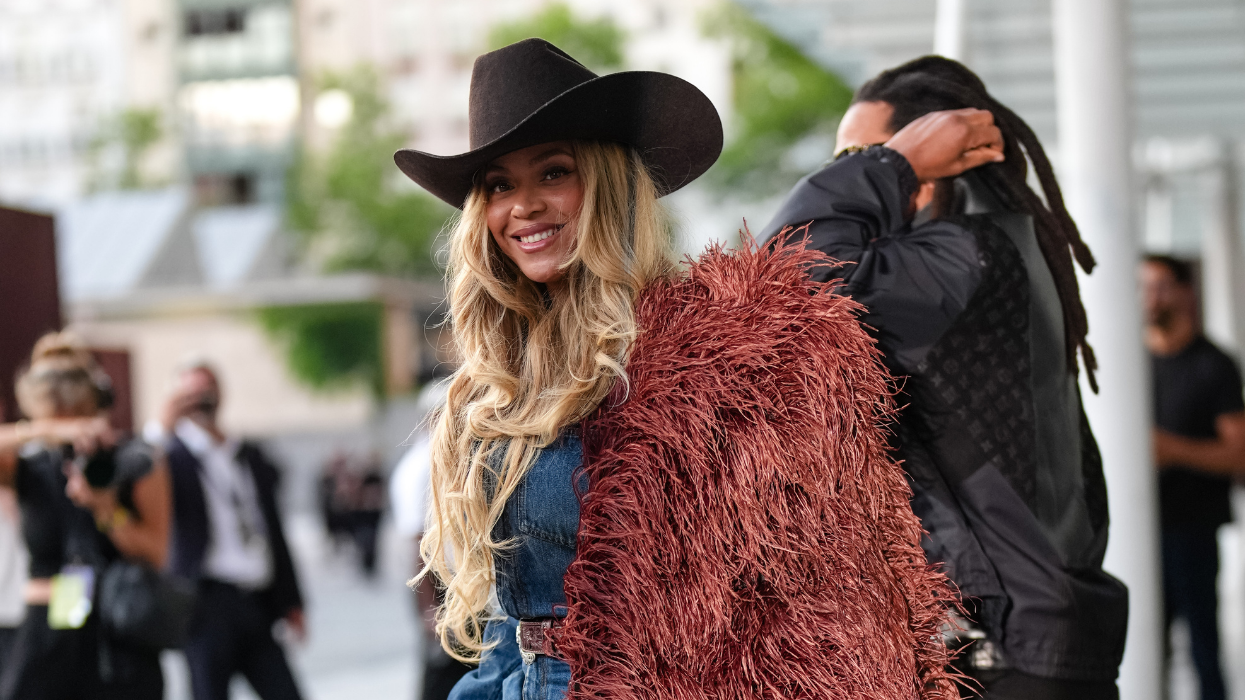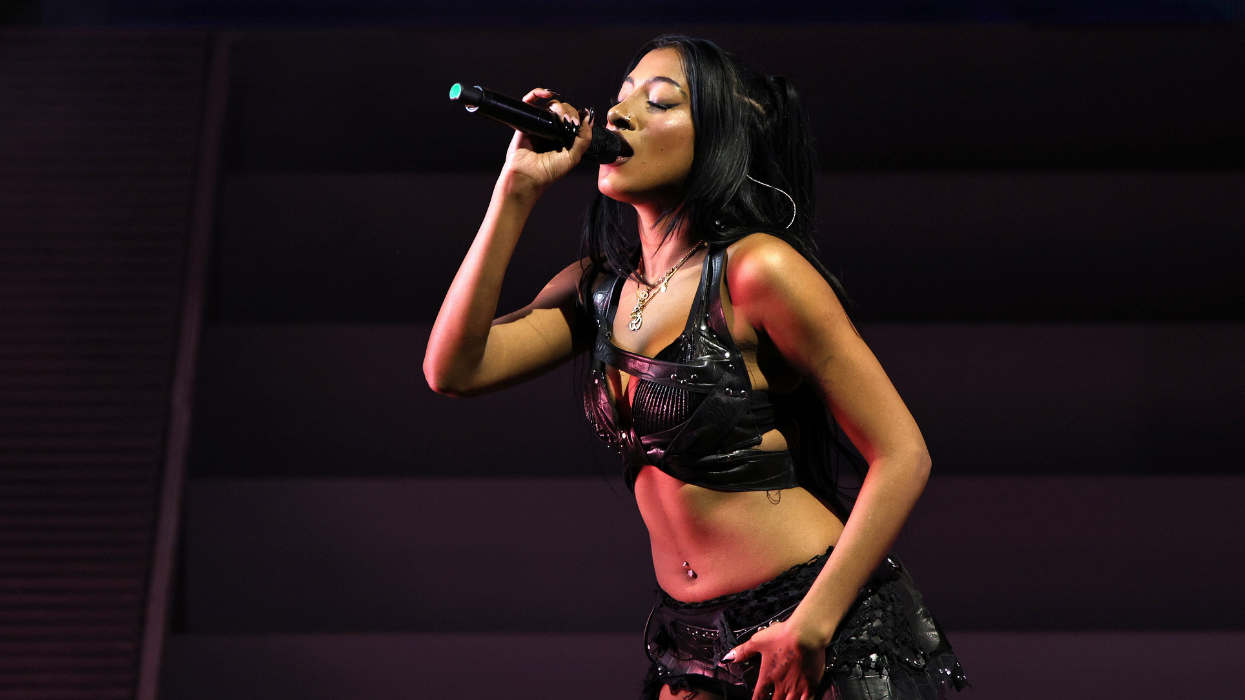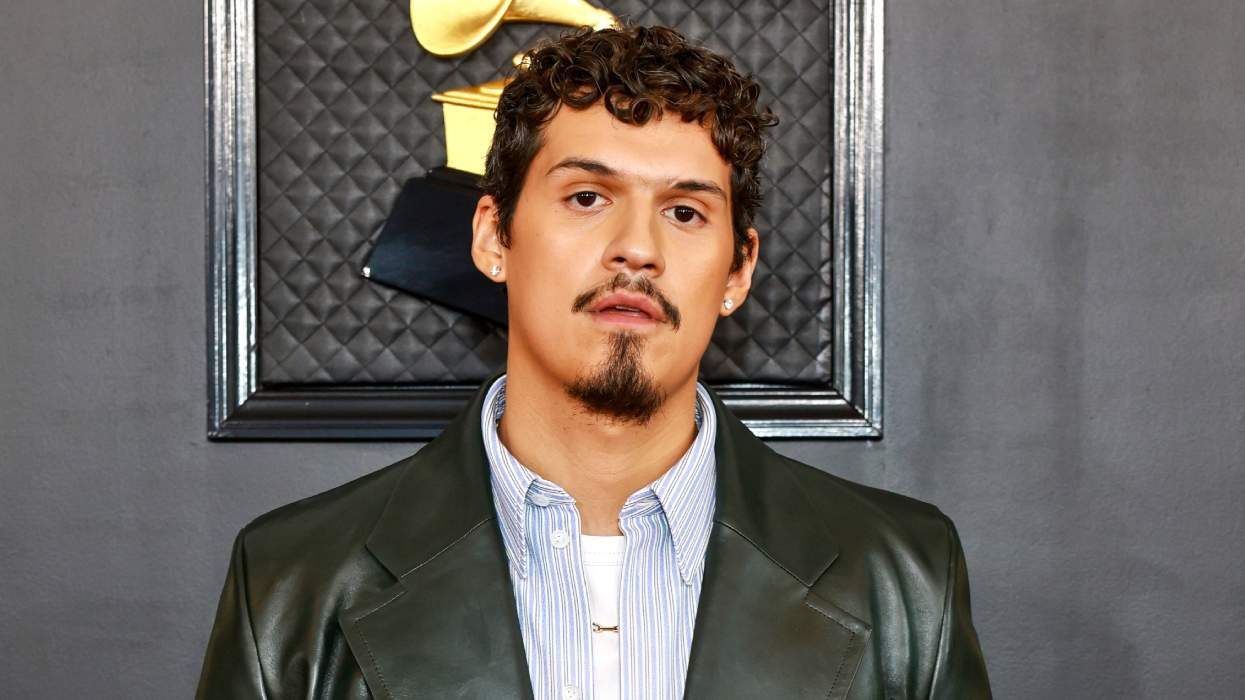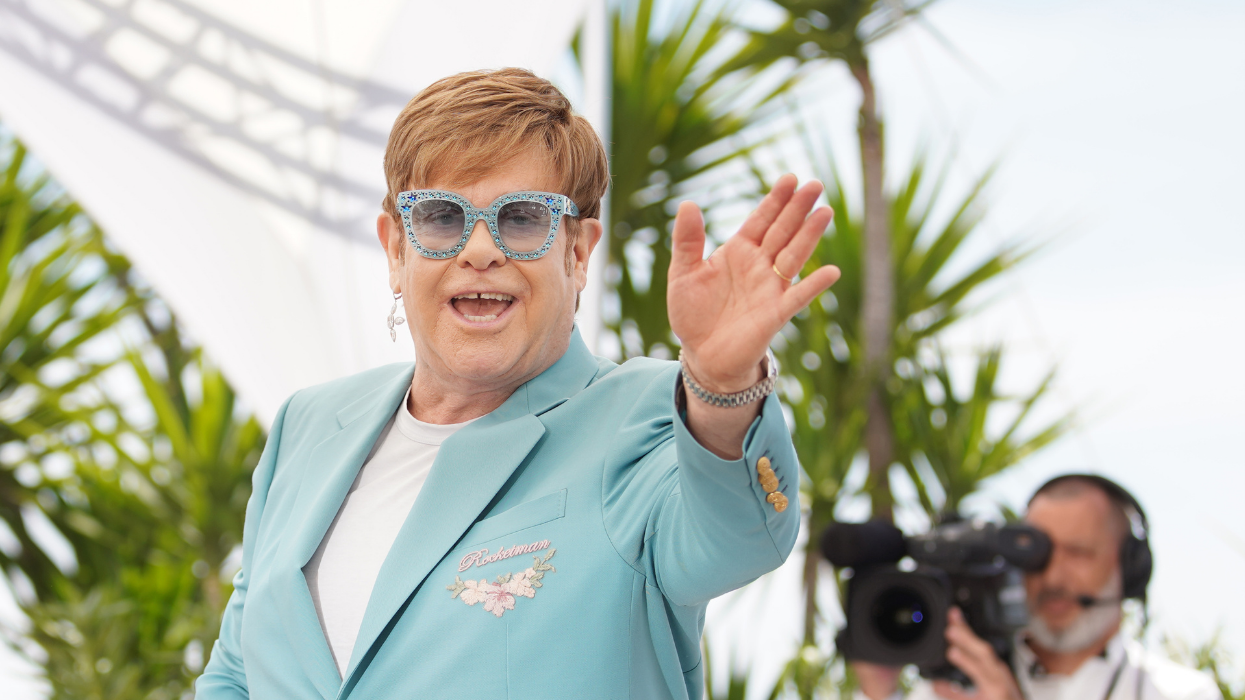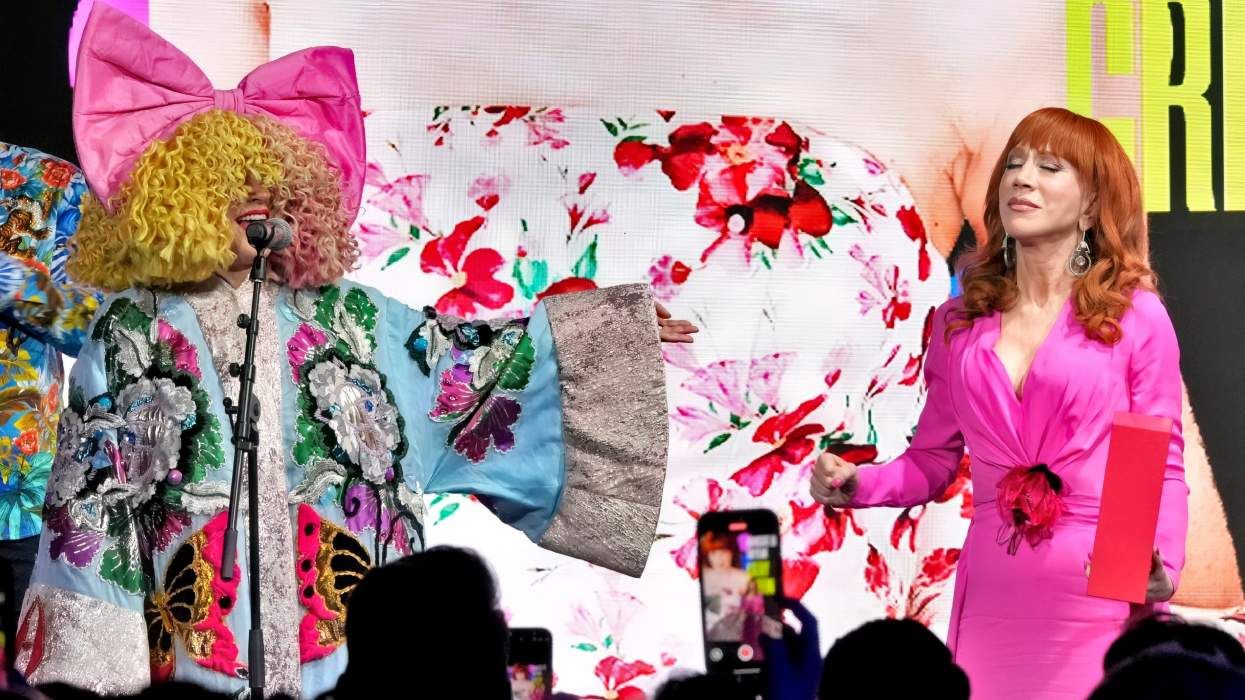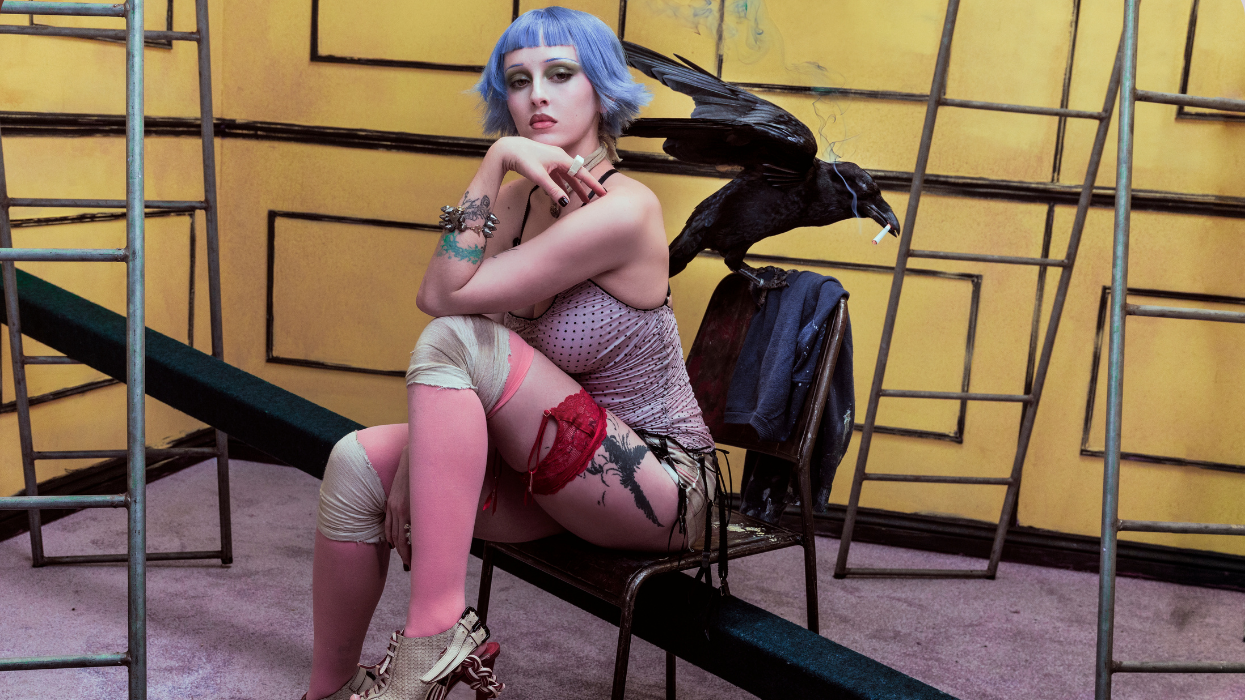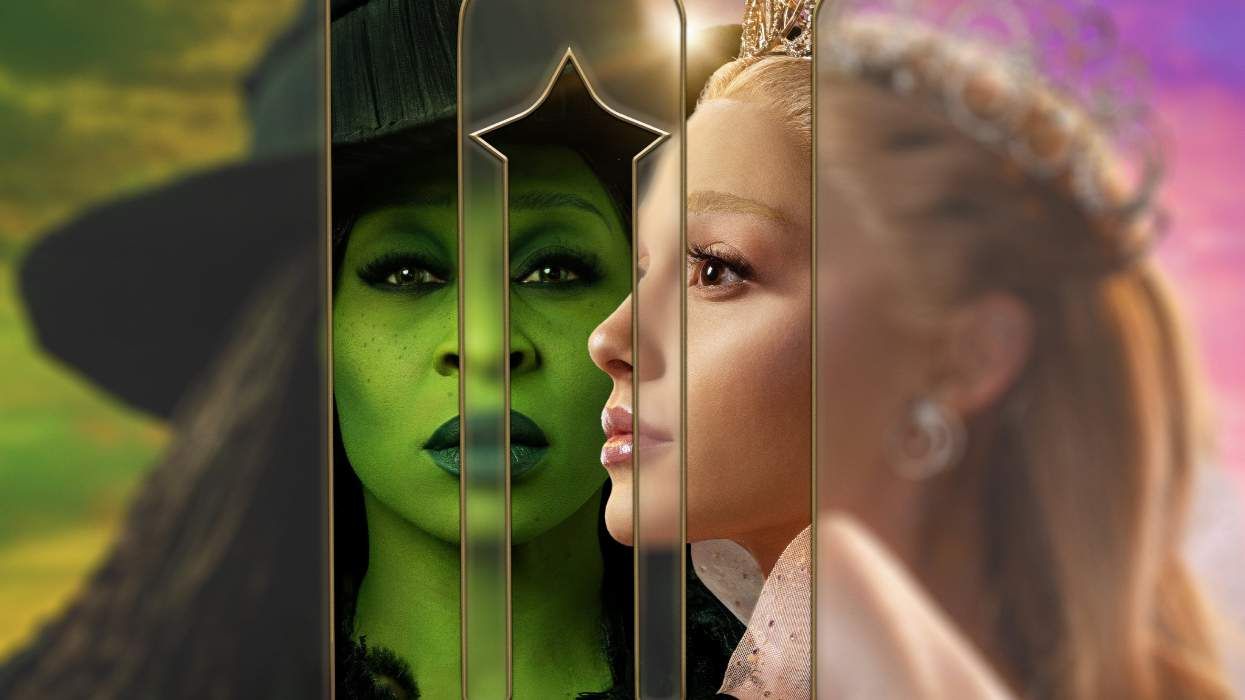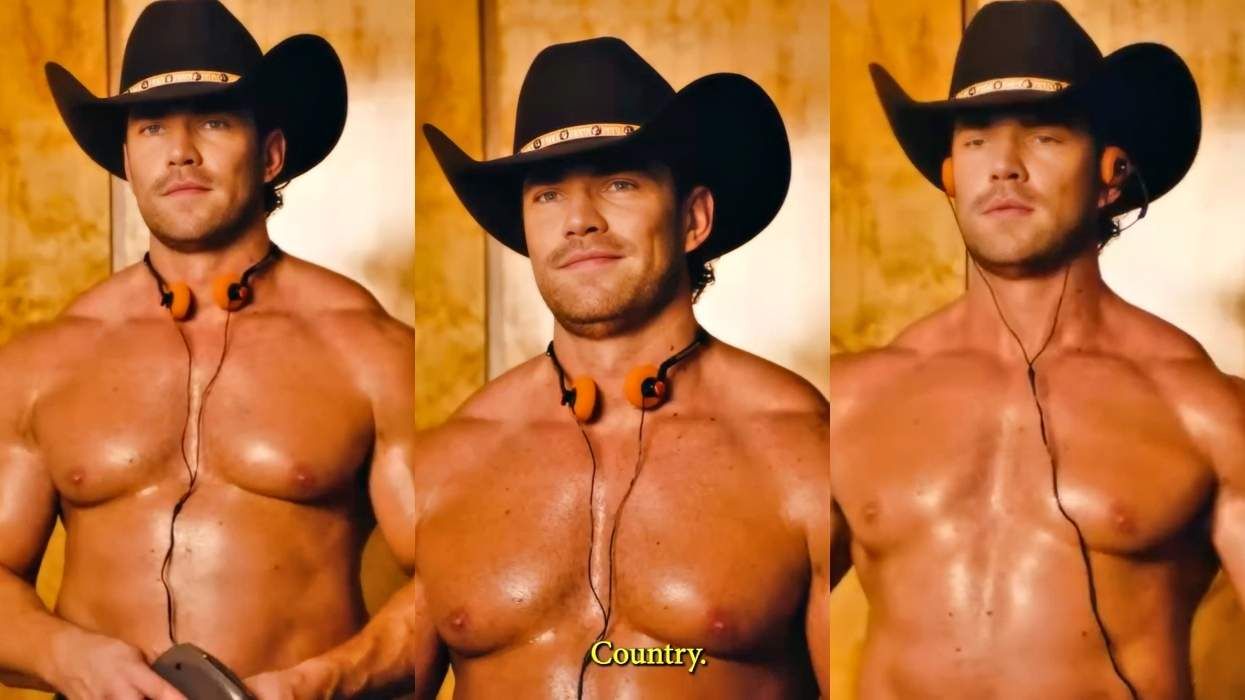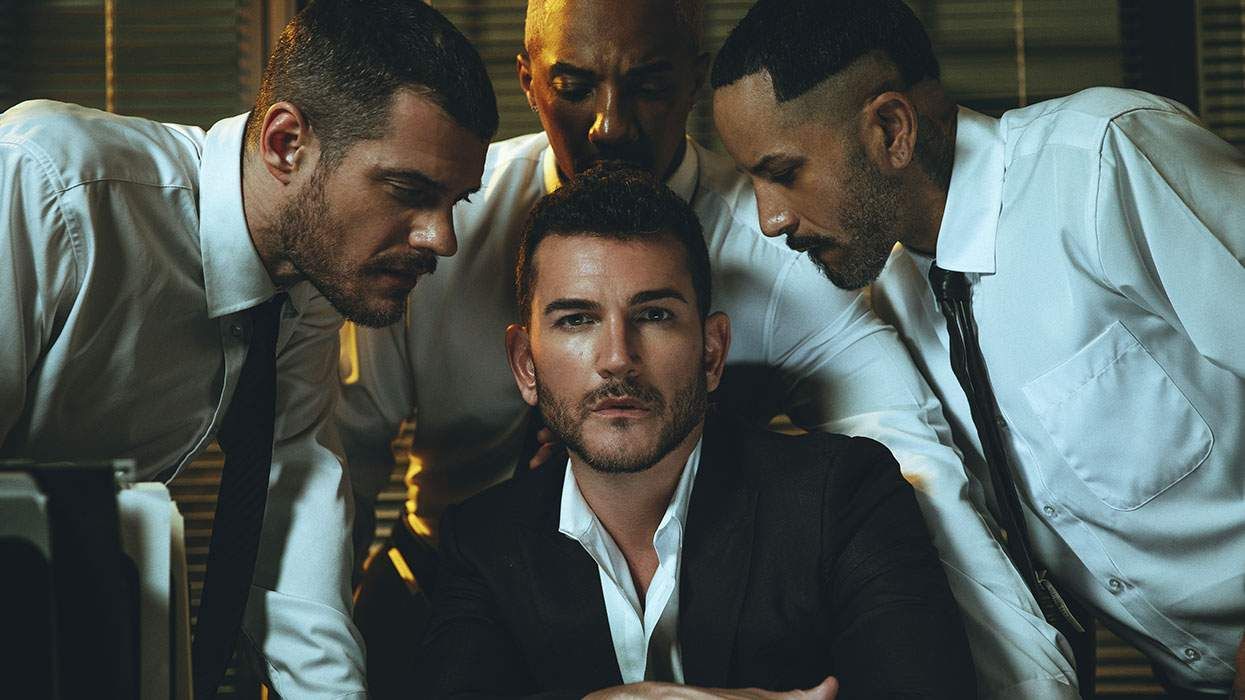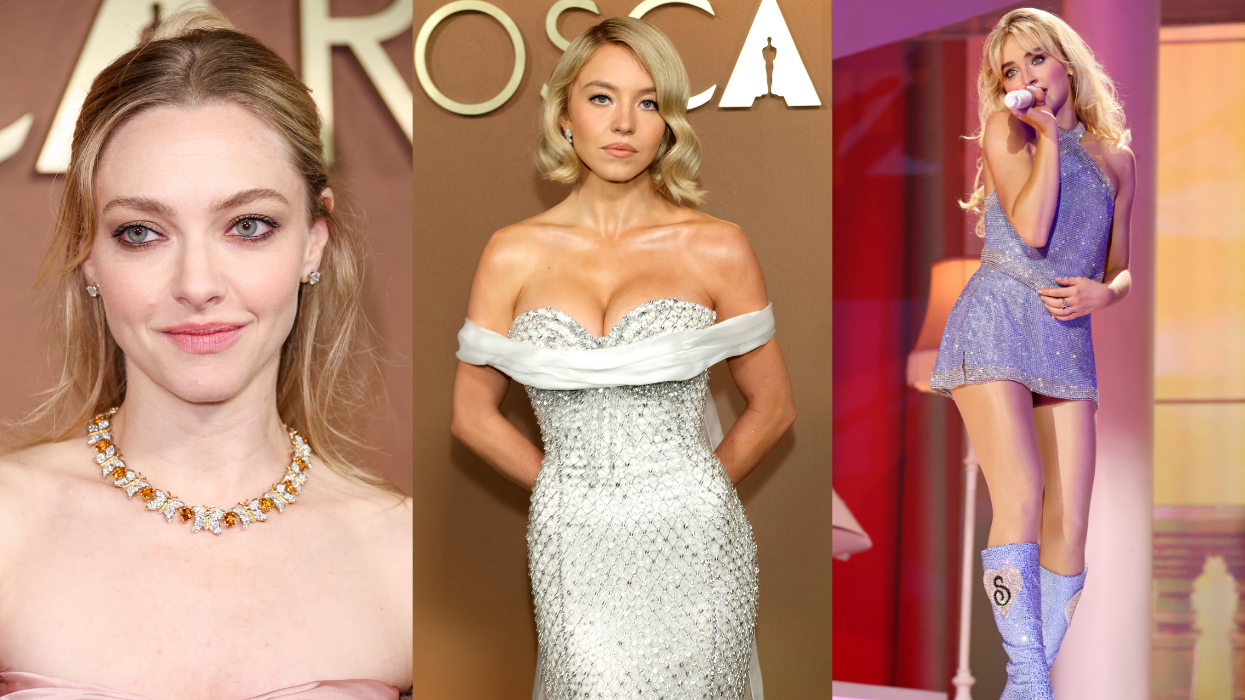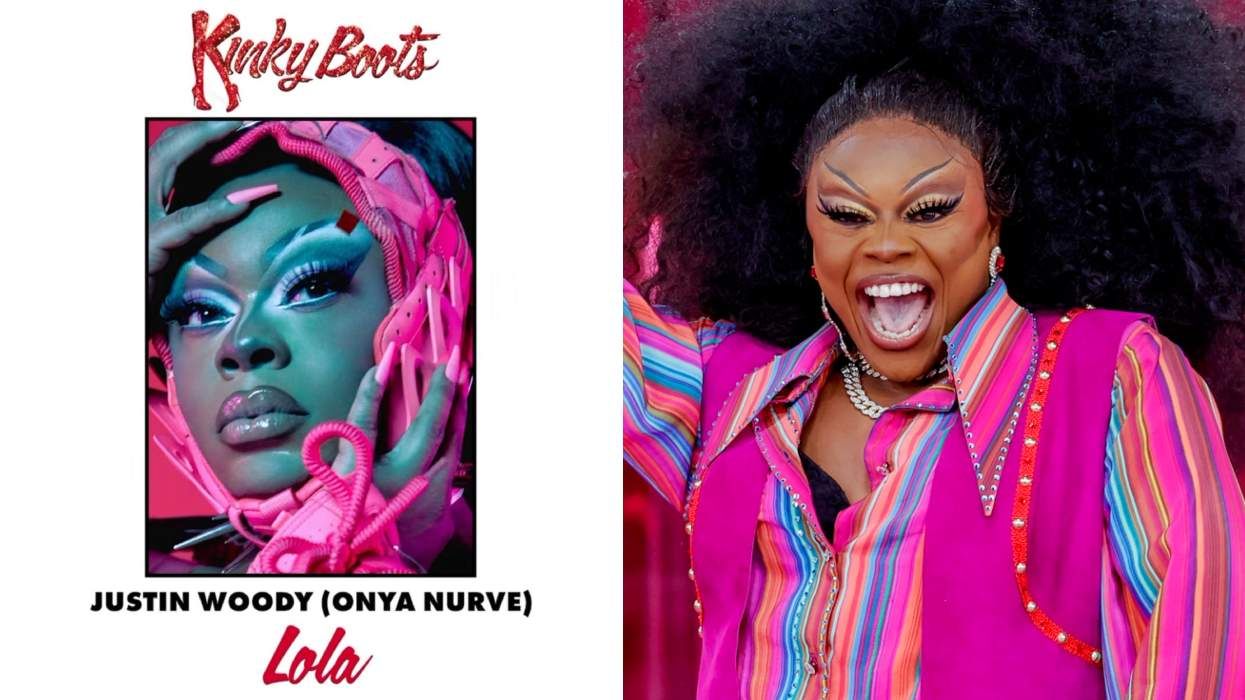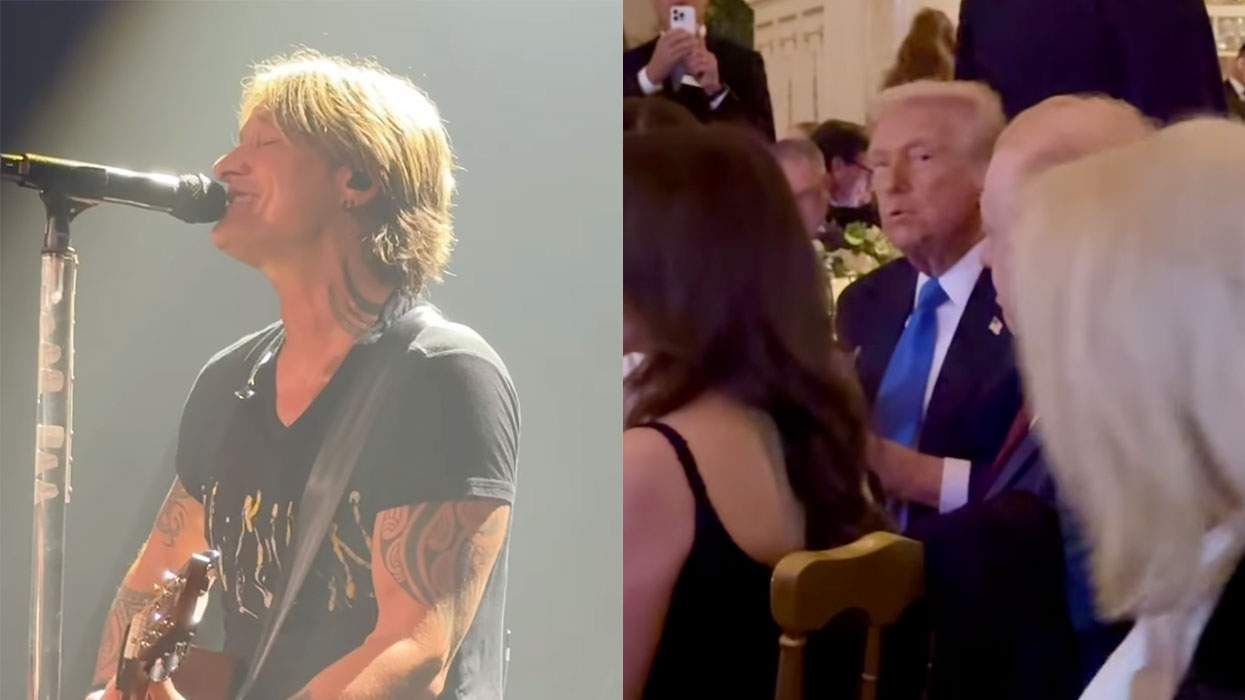Photo above: Queer punks crash the San Francisco Pride parade (June 25, 1989). G. B. Jones (center) sits on the hood of a battered police-car float, smoking a cigarette next to a sign referencing the Stonewall riots. (Photo by Danny Nicoletta)
After the sexual free-for-all that was 1970s glam rock, the pendulum swung back. The 1980s alt-rock landscape was impossibly straight. That's ironic, since its holy trinity -- R.E.M., Husker Du, and The Smiths -- was made of bands whose frontmen are now respectively queer, out, and sexually nebulous. But in the darker corners of the underground, bands were sprouting up that were defiantly -- and loudly -- gay. The Queercore scene grew out of a generation that bristled against what it saw as the bourgeois trappings of a mainstream gay lifestyle and the macho, hetero hardcore scene that punk -- a movement founded by women, people of color, and gays -- had become. Queercore was a call to arms and storming out of the closet. The literature came before the music. It started out as a loose collective, trading fanzines and letters, and evolved to include dozens of bands, as well as the extraordinary friendships and treacherous rivalries that come along with creative intensity. Here's an oral history of Queercore, from its inky, Xeroxed beginnings until it rendered itself obsolete.
There was a gay element to early punk, such as the Los Angeles group The Germs -- whose singer was the closeted Darby Crash--as well as Seattle transplants The Screamers, The Apostles in the U.K., and, in Texas, The Dicks. The original scene encompassed a proto-stage of what would become Queercore.
GARY FLOYD: The thing that set Austin apart in 1979 was that there were always a lot of queers in the scene. There was a big influence from the artsy radio and television department at the university. I started The Dicks. I met the other guys, and, while it wasn't exactly true, I told them I already had a band. The scene was so young and uninfluenced; we didn't have to live up to anything. Soon, other bands that had gay people started showing up. The popular bands in Austin were fronted by openly gay guys.
We weren't touring much in the first few years; other bands came through here, like Black Flag, Fear, and The Minutemen. I didn't meet a lot of queers; Husker Du came, but were in the closet. They stayed at my house. One night I caught Bob Mould looking at a gay magazine we had on the table. He put it back real quick.
BOB MOULD: I don't know if I was actually going through Gary's porn collection, but you couldn't help but see it. Sort of like saying to somebody else, "I see you've got the new Vanity Fair on your coffee table."
In the '80s, a group of disaffected twentysomethings, horrified by mainstream gay culture and the emergence of straight-guys-only hardcore punk, documented a gay punk utopia in fanzines -- even if it was mostly imaginary.
DENNIS COOPER: You're talking about something that started around 1985, but didn't seem to be hugely healthy until the end of the '80s. Just before that, there had been Queer Nation, which was hard-lined about gay identity and how it should be portrayed and what it should mean. Queer punk came out of the energy of punk rock. It brought lesbians and gays together on a more even footing than they had been and was even inviting to straight people, saying that you don't need to fuck people of your own gender to be queer.
BRUCE LABRUCE: I was getting my degree from film school. I lost interest in academia and started hanging out in the art and punk scenes in downtown Toronto. There was a particular restaurant circuit where people worked as waiters and cooks. They were these bohemian places--one was called Just Desserts, and the owner was this ex-art student hippie who hired all the punks and junkies. That's where a lot of us ended up meeting. I was at work, at Just Desserts, probably in 1985. There was this striking, imposing woman with red, fright-wig-type hair. I was fascinated by her.
G.B. JONES: These two smart women with incredible style -- Kathleen Pirrie-Adams, who played bass, and Janet Martin, who played guitar -- told me they were looking for a drummer. I had only drummed once before and didn't know how. I said right away that I wanted to join, because they were unlike anyone I'd ever met.
BRUCE LABRUCE: Fifth Column was a hardcore feminist punk band. Their first LP was To Sir With Hate. They were anti-patriarchy women playing in a male, macho scene. They were intimidating. When G. B. Jones -- or Gloria, at the time -- and I became friends, we had an intense relationship. For six years, it was almost like lovers, but without sex. It was romantic and intense. She's a brilliant artist. She mentored me, basically.
TOM JENNINGS: In the summer of 1987 or '88, there was an anarchist gathering in Toronto, which was a watershed event for lots of queer people. While the macho, dickhead punk-rock boys were off overturning mailboxes and getting into fights with the police, the rest of us were networking, realizing there are all these weirdo punk, queer, street culture people who are not particularly interested in that macho stuff.
MARK FREITAS: Bruce and G. B. Jones had created this zine that depicted this scene that didn't really exist, other than in their minds. They made themselves larger than life, the superstars of this "gigantic" queer-punk scene in Toronto.
BRUCE LABRUCE: It was J.D.s, as in Juvenile Delinquents. That was the initial inspiration [for the zine]. It also stood for James Dean and J. D. Salinger. And I was drinking a lot of Jack Daniels at the time. We borrowed from The Situationists quite heavily -- this idea of creating a spectacle and propping it up in the media, even though it was fiction. We created personae that we hid behind, in a Wizard of Oz style.
JENA VON BRUCKER: People in small towns were writing G. B. and Bruce, "Oh, my God, I thought I was the only person on Earth who felt this way!" Suddenly, there were people all over North America printing off fanzines and sending them to each other.
TOM JENNINGS: The reason I went to Toronto was J.D.s, done by Bruce, G. B., and Bruce's roommate, Candy. She's fallen off from punk-rock queer stuff, but had published a zine called Dr. Smith, named after the character from Lost in Space. She was this faintly chubby girl with pigtails. Bruce, G. B., and Candy just made shit up. They made up that there was a queer-punk underground. I went back to San Francisco to make my own zine, Homocore: core, as in essential; homo, as in queer.
BRUCE LABRUCE: G. B. and I had an acrimonious split after I made my first feature film, No Skin Off My Ass. I was accused of selling out. Dennis Cooper wrote in the Village Voice that I was "careening with a Jayne Mansfieldian blatancy," which I later quoted on the back of my book. I caught a wave of what was called the New Queer Cinema. The nascent LGBT film-fest circuit was emerging, and my film got international attention. There was a certain amount of resentment around that, and accusations of not giving people credit. Some of it is valid, some of it isn't. G. B. was the costar. There was a lot of improv in the film, and she wrote some of her own dialogue. In retrospect, she should have gotten a cowriting credit.
JENA VON BRUCKER: With so many things, once they get past the countercultural and subversive and get media attention, the infighting starts. It's not like they just decided not to put out any more issues of J.D.s. Bruce was enjoying popularity with the movie, and the two of them had achieved a certain notoriety. Things like that will test any friendship. There was more of a public war than there should have been.
STEVE LAFRENIERE: The "Great Toronto Zine War" is a compelling story. Bruce and G. B. split up, and it got crazy with the introduction of Johnny Noxzema, a real bomb-thrower. He put out the most important zines of the period, Bimbox and Double Bill. He sided with G. B., and they had this incredible war against Bruce.
BRUCE LABRUCE: Johnny Noxzema is a piece of work. His boyfriend, Rex, had a wooden leg--we called him "Pegleg"--and he was a psychiatrist and the sugar-daddy. Johnny was his younger, skinny, volatile, intelligent sidekick--or Frankenstein's monster. They were shit-stirrers, which I completely identify with, but they did it in an abrasive, over-the-top way. At the height of the AIDS crisis, they stapled a condom into every issue -- with a hole through it. They were Machiavellian behind the scenes, turning people against each other. One of the worst victims was Candy, who's brilliant and probably the best artist of us all. They were extremely nasty. They did this zine about her called 99 Chins.
JOHNNY NOXEMA (to The American Music Show: A lot of Americans didn't understand our hostility towards the homosexual community at large. It sort of took them aback. Double Bill is a magazine we'd done with G. B. Jones and Jena von Brucker, who are probably the most important homosexuals alive today.
JENA VON BRUCKER: 99 Chins was nothing but a direct attack. The difficulty with Bruce and G. B., this public feud and splitting of camps and almost splitting the scene, initially solidified our friendship with the boys from Bimbox and was part of what caused G. B. and I to move away from them eventually. A common enemy bonds you, but you don't want to spend the rest of your life saying Candy is overweight and Bruce is a monster.
JOHNNY NOXEMA (to The American Music Show: We're gonna nail those fags to the cross, so to speak. They're going to get everything they deserve... Our main beef is that all these homos go around thinking that they are the most oppressed group of people on Earth. It's just not true. They are, like, fourth or fifth down the list. And in some ways, they are more privileged than straight men, and we all know the reasons why. It's about time that someone started to tell the truth, that's all.
JENA VON BRUCKER: Double Bill came about at 3 a.m. We were having a discussion about William Burroughs, this revered gay icon. There is this glaring information, that he shot his wife in the head, that people seem to ignore. That got lumped in with this other idea that there was a lot of hatred for women in the gay-male community. Johnny and Rex spoke out against it. At the same time, Cannon reruns were on late-night TV, and we had this great affection for William Conrad. We got this idea to create a fanzine to juxtapose Conrad, nice guy and lover of women, against Burroughs, a horrible and creepy misogynist.
As the Toronto zines made their way around the world, similar publications -- and the bands that often accompanied them -- started popping up in other cities.
STEVE LAFRENIERE: People weren't saying "queer" quite yet. It was just coming together, as far as language and what totems were invoked. These kids up in Toronto made amazing zines that made fun of not only the world, but specifically the gay world. And it was being made by gay people. I happened to know these kids in Atlanta who had a cable access show called The American Music Show, a bunch of teenagers named Lady Bunny, RuPaul, and Larry Tee.
VAGINAL DAVIS: A scene was developing in New York -- with Linda Simpson and her My Comrade and the Pyramid gang and the zine Pansy Beat -- and in Chicago with Steve Lafreniere and his clique. A lot of us didn't officially meet until SPEW: The Homographic Convergence at Randolph Street Gallery in Chicago, organized by Lafreniere.
STEVE LAFRENIERE: It was an all-day affair in May 1991. There were tables, a stage with performances, manifestoes being read, weird drag, and bands. That evening, we went to a place called Hot House, a performance club run by crazy lefties. Fifth Column and Vaginal Davis performed. Vaginal brought down the house. It was this amazing night. Oh, and I got stabbed.
LARRY-BOB ROBERTS: A lot of people came to SPEW -- Vaginal Davis came from L.A., Bruce and G. B. came from Toronto, though at that point they had already had a legendary falling out. Johnny Noxzema was there, from Bimbox, the notorious Toronto zine that said people who work for glossy gay magazines should be gay-bashed. Mark Freitas, who did Homocore Chicago, was there.
STEVE LAFRENIERE: I was standing outside with Vaginal, right after she came offstage. Some guy drove by and yelled, "F****ts!" Having just seen one of the most momentous performances of my life by this incredible creature from another world, I ran up the street, and, when the car got to the light, I got my head in the window and started screaming at the guy. He got out of the car and stabbed me in the back. The next thing I remember is being lifted into the ambulance. He missed any kind of internal organs that would have meant my demise. They never did catch the guy.
Music overtook writing as the preferred medium for Queercore, and bands like Tribe 8, Pansy Division, Cypher in the Snow, and Sta-Prest formed.
LYNN BREEDLOVE: There were rocker queers and disco queers. In high school, I hung with the rockers. We were listening to Journey and Queen. There was no queer music. Freddie Mercury wasn't even out! But we could tell by looking at him. We would come together at the discos, where we would take our fake IDs and do the hustle. As time progressed, my friends were listening to Black Flag, and I was like, What the fuck is this? It was sarcastic and hilarious, and gay in that it was camp, ironic, and making fun of yourself -- but totally hard-edged and "fuck you."
DONNA DRESCH: In high school, a bunch of kids listened to Christian rock. They were listening to this music they were really passionate about. Then I discovered punk. I played in Dangermouse and joined Screaming Trees and then went on tour with Dinosaur Jr. That's about the time that I figured it out: I love playing in bands, but I'd like to do it with people like myself.
JOANNA BROWN: When I was 15, I lived in a small town in Louisiana, and the record store carried New York Rocker. I knew I was queer, but it was horrible because I was the only one. The magazine had a spread on famous couples in punk, and there was Adele Bertei of The Contortions and her girlfriend, Lesley Woods, of the Au Pairs. I was so impressed that there was a lesbian couple; I realized, maybe it was OK to be queer if you were into punk.
JON GINOLI: I got involved because I didn't see anyone in music who was out, except for people involved in dance music, which I didn't like. You were supposed to like show tunes and disco. That was one of the hardest parts of coming out for me--finding out what seemed normal to me offended a lot of gay people.
LIZ NAYLOR: Punk was liberation from a life of Jefferson Starship. I didn't know how I was going to survive in the world as a 14-year-old lesbian. Punk, though it didn't give me any answers, gave me an escape from what I thought would be a hideous future.
JON GINOLI: I formed Pansy Division, with Chris Freeman, because there were no other gay bands. As it turned out, a few others formed around the same time. At the second Pansy Division show, we were on a bill with Tribe 8 -- we hadn't heard of them. I thought, Great, we have comrades!
LESLIE MAH: I hitchhiked from Colorado to San Francisco when I was 18 to see punk shows and queers. A friend of mine came back from San Francisco and said, "Men were holding each others' hands in the street... it's so disgusting." And I said, "I wanna go."
DONNA DRESCH: I was corresponding with G. B. Jones. I had discovered Fifth Column when I was reading through an issue of Flipside. They had written a letter saying, basically, We're gay and you're not covering us. We wrote back and forth for years. It kept me alive.
Despite thriving scenes sprouting around the country, San Francisco became the unofficial capital of Queercore. There was an abundance of bands, activists, artists, and zinesters.
TOM JENNINGS: The Shred of Dignity Skaters' Union was formed by me, Duke Crestfield, and Shawn Ford. Some idiotic city supervisors had decided to ban skateboarding in the streets of San Francisco. The ban was overturned by having 100 skateboard kids show up at City Hall and cause a ruckus. The three of us started organizing punk and skate stuff that was slightly queer. By 1988, Shred of Dignity had a warehouse and there were a bunch of us living in it, doing marketable political organizing and Homocore, the gay punk zine that first came out in '88.
DONNA DRESCH: Around 1989, I moved from Olympia to San Francisco. We lived in a U-Haul. Eventually I moved into the Homocore warehouse.
TOM JENNINGS: Bruce or G. B. said the word "homocore," and I swiped it. I made up the kind of punk world I wanted to live in. It was a juxtaposition that mattered to me, and it attracted a lot of people. I took it to bookstores. We started to put on Homocore shows. Our favorite spot was at the base of the Bay Bridge. We'd show up with a band, and start playing until the police told us to leave.
SILAS HOWARD: One of the big moments was a gay pride parade in 1989. We saw a float obviously crashing the parade -- a tow truck pulling a cop car -- and on the front was a big banner that read, "No Apologies, No Regrets." It was surrounded by punks and queens. There was this big high-heeled show on the cop car, and a bunch of punks pulled out baseball bats and started beating the shit out of the car.
LARRY-BOB ROBERTS: Now there were bands; they needed places to play. Homocore Chicago started putting on shows in places like bowling alleys. In San Francisco, there was this collective-run record store called Epicenter Zone. A number of people who volunteered there, who were queer, started putting together once-a-month shows under the name QTIP, Queers Together in Punkness. There was an underground club scene associated with this night called KLUBSTiTUTE, run by people who had an art band called The Popstitutes. The person who had the biggest success from that scene was Justin Bond.
JUSTIN VIVIAN BOND: Shortly after I moved to San Francisco, I saw a flyer for a Homocore show at the York Theater, on Mission Street. The Popstitutes were playing, along with the poet Richard Loranger and a bunch of queer anarchists. The afternoon was mind-blowing. Without doubt, that day changed my life and set me on a course toward a creative and political aesthetic that, until then, I had never been exposed to or thought possible.
MATT WOBENSMITH: There had been a network of queer punks created via J.D.s and Homocore, but there was always this idea that they were creating a scene that existed in glimpses. In order to be realized, it needed bands. The seeds of Queercore music started happening, largely in San Francisco, with Pansy Division and Tribe 8. It was the perfect storm to set sail in.
Queercore shows became more than just entertainment -- they became places to cruise, to network, to take self-defense lessons.
KAIA WILSON: Adickdid was my first band. In that band, I was like, I gotta play with girls. Eventually I was like, I gotta play with lezzies.
JODY BLEYLE: I had people I was playing music with, and I loved them, but it wasn't fulfilling me. Then I got asked to join Hazel. After a year, I remember putting my head on a friend's bosom and saying, "I'm never gonna find any queer girls. How will I find people like me?"
DONNA DRESCH: I needed to play with people like myself. I needed to find girls who understood the music I liked. That's when Kaia's band, Adickdid, and Hazel came through town, and I was like, I've gotta hang with these girls. I grabbed Jody and Kaia and was like, "We have got to do this." From then on, we were a band.
LYNN BREEDLOVE: We sucked. We were terrible musicians but had something that never existed before, which was a bunch of dykes getting up and saying, "We are dykes. This music is for you."
I got one of those $10 dicks -- you know, a dollar an inch, at the porno store -- and I was waving that shit around and singing about rape. It was somewhere in Kentucky, and it was strapped on, and I was waving this giant knife. Everyone was in this swarming pit of fury, yelling, "Cut it off!" I did and threw it into the crowd. That started a tradition of bringing a bag of rubber dicks on tour. The dick-makers in San Francisco, Good Vibrations, would give us their rejects.
JOSHUA PLOEG: One of the things was not to necessarily make queer culture more acceptable, but to make queer people feel like they could do whatever they wanted. It's not to be more included, but to feel like you're able to do something, no matter how crazy.
LYNN BREEDLOVE: You can make a dick last a couple of shows. First, you chop off the balls, then you chop off the dick. You had to get a blowjob before you chopped off the dick, because if you had a song about chopping the dick off and then you had the blowjob song, you were fucked because you didn't have a dick to suck anymore.
It wasn't always easy -- especially outside the bubble of a major city.
MARTIN SORRENDGUY: I would say stuff on stage about being gay, and it was insane. It wasn't cool for certain people. You would hear, "I used to love [Los Crudos] until he started talking about f****t shit." The negativity made me feel more powerful.
RACHEL CARNS: There was the feeling of being at war and not letting the bullshit people were trying to throw at you touch you.
SARA MARCUS: I remember seeing Rachel Carns before a show, drawing in her eyebrows and mustache with a Sharpie in the side-view mirror of their van and saying, "I don't care if straight people come to our shows. We're not doing this for them. They don't have to come, and we don't need them to feel welcome."
DONNA DRESCH: It was our second show, and we were playing in Portland. Team Dresch was ready to confront anything, but this was totally unprovoked. We were loading our equipment when some guy started in. He called Jody a "fucking dyke," and she was like, "Yeah, I am," and he jumped out of his car and sideswiped her with a punch to the head.
KAIA WILSON: That's how we started as a band, with a random act of homophobia.
JODY BLEYLE: He wasn't indicted because the grand jury said I shouldn't have been out so late.
RACHEL CARNS: The first tour, we brought a gun. How stupid was that? I can't believe we toured the whole country with a gun under the front seat of our pickup truck. We never had to use it, and wouldn't have known how to use it if we had to. There's this whole other part of touring that isn't the shows. It's the truck stops and has stations where you have to stop and eat. Those places were scary.
LUIS ILLADES: A couple times, especially in the Midwest and South, kids wanted to run away with us. One kid ran away from the home of his super-Christian family and came to our show. He had all of his belongings with him, and he came to see Pansy Division because there was nowhere else for him to go. He asked us to give him a ride to wherever we were going next. He was 15, and it was heartbreaking. He had come out to his family, and his father tried to beat him up and kicked him out. He wanted to escape with the gay circus.
KAIA WILSON: I wasn't able to understand at that point that I was a mentor. That had to happen in hindsight. We were part of something huge. Later, kids would be like, you saved my life. It wasn't what we set out to do.
Queercore has its brush with the mainstream and commenced a symbiotic, problematic relation-ship with Riot Grrrl.
JON GINOLI: Green Day catapulted to fame. They had been on the same label as Pansy Division, then had gone to Warner Bros. and suddenly were face-to-face with all these people who had no idea what the context of their band was. They decided to take Pansy Division on tour to show what their band stood for.
BILLIE JOE ARMSTRONG: I had a feeling Pansy Division would definitely get a mixed reaction. When our crowds were getting more mainstream, we didn't want to represent the typical Mohawk stereotype. Pansy Division was truly challenging, and their songs are melodic and catchy. I got letters from teenagers saying, after seeing Pansy Division, they had the courage to come out. I saw certain idiots in the crowd yelling "f****ts" or throwing shit. But I also saw people dancing and having a good time. Homophobia has no place in the punk scene or the mainstream. I think we share that belief with Pansy Division. Punk rock has been rather queer since the beginning.
MATT WOBENSMITH: There's a Dyke in the Pit was my first release on Outpunk Records [the first queer punk label]. I had helped with another record called There's a F****t in the Pit. The reaction was phenomenal. I was influenced by Riot Grrrl, which energized me.
JODY BLEYLE: The queer bands were filled with feminists, and so was the Riot Grrrl scene. There was an enormous amount of overlap. Team Dresch never considered itself a Riot Grrrl band; it was a Queercore band. When people think of feminism in the '90s, they think of Riot Grrrl, but because Riot Grrrl doesn't include Queercore, it usurps it. It erases it. You don't want queer history to get erased, and that's what happens when you don't scream about it.
DONNA DRESCH: Riot Grrrl gets talked about more, but we didn't identify with that because it was mostly a straight movement. We were allies, but we were on separate paths.
Not long after, the scene began to wither, partially exhausted by years of burning hot, the mainstreaming of alternative culture, and the Internet, which made finding a world that accepted young gay people easier.
MATT WOBENSMITH: It was at its apex. We came up with [the festival] Dirty Bird. I think it signaled the beginning of the end.
ED VARGA: When Homo A Go Go [festival] started in September, 2002, I felt like, Wow, we can have a whole queer music festival. People came from all over; they called it a gay-cation.
SCOTT TRELEAVEN: I was invited to Dirty Bird and thought, I'm going to get laid left, right, and center at this big gay punk thing. The dykes wasted no time hooking up. Most of the boys were organizing zine swaps and symposiums on passive resistance, but no one was fucking. I was with hundreds of cute gay punks, and no one seemed to be making a move. Vaginal Davis performed, and I was flirting with this hippie boy who ended up inviting me to a Radical Faerie gathering. I got thoroughly laid there.
MATT WOBENSMITH: We had achieved everything we wanted to do. For me, it was no longer a challenge just to have homo rock.
DONNA DRESCH: In the 2000s it started fizzling out.
G.B. JONES: Now it's time for people to begin to address the issue of how so much of the work we did has been, and is being, appropriated.
MARK FREITAS: My one misgiving with all this is that we're in such a nostalgic time now. It's not just that I'm old--there is nothing culturally right now that feels new and exciting to me.
BRUCE LABRUCE: It's too bad it got so acrimonious, but perhaps that's a testament to how intense and brilliant the whole thing was.
DONNA DRESCH: I can't tell you how many letters I got from people saying they would have killed themselves if they hadn't heard the band. I'm blown away we had that impact on people. We're just four dykes who make music.
LYNN BREEDLOVE: As long as we're not shutting up, we're still pressing the queer punk ethos. We're still spreading inspiration for everyone else to create something that expresses who they are, whether it's in a band or one person standing alone in a spotlight, standing up for it and helping everyone else out there.



